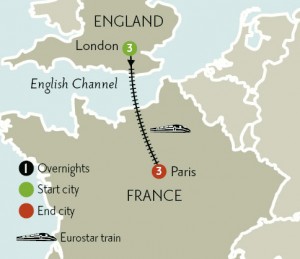business eikaiwa expectations high school junior high school school management study trips young learners
by sendaiben
17 comments
Taking Students to Europe (2013)
After the (semi-)successful study trip to Australia’s Gold Coast in 2012, we decided we wanted to do something similar this year.
In Australia, the best things we did were as a group, and the worst part of the trip were the host families, so this time we tried to put together a kind of eye-opening cultural tour, with a week in London and three days in Paris.
The students were interested but their parents weren’t. “Sounds like you’re just going on a trip”, they said, and weren’t open to the argument that it was the kind of trip that most kids in Japan never have the chance to make.
We quickly rethought our plans and changed the trip to incorporate a week’s homestay/English classes in London with three days in Paris. Seven students signed up, fewer than the ten we had set as a minimum. I wanted to cancel, but the school manager decided to press ahead as a learning experience.
We went with a company in the UK recommended by a friend of mine. Big mistake.
The problems
1. The school we partnered with for this trip was disorganized and unprofessional. The frequently forgot things, failed to deliver on previously agreed conditions, and three days before the trip emailed me saying “we couldn’t find the last homestay family for you, so let’s just refund your money and call it quits”. Our office manager physically collapsed when I relayed that message. I was able to broker a solution eventually, but it was incredibly stressful. After we arrived, instead of providing staff to guide us on field trips as agreed, they dropped us off at various places leaving the teacher accompanying the students to try to salvage things and provide tours and activities on the spot. Classrooms were booked at the wrong time, activities were booked on the wrong day. Scheduled activities had to be changed because they were not available on Sundays, and so on. Instead of providing classes for each level of student (we had three different levels of ability) they just provided two. None of this was said in advance, it just happened and we decided to just get through the experience without upsetting the students rather than argue.
2. Organizing everything ourselves meant dealing with airlines, hotels, transport companies, schools, museums, restaurants, etc. Once we were in country, the sole teacher on the trip had an excessive amount of responsibilities and stress. For example, on the last day we had a guided tour of Versailles including pickup from the hotel and drop off at the airport, but until the minibus actually turned up we couldn’t be sure it would happen so had to have a plan B in place. Everything turned out okay in the end (I don’t think the students noticed the problems) but it was a bit too intense.
3. Due to a last-minute venue change (from London to Cornwall!) we ended up needing to take two long (6-hour) journeys by minibus. This was a bit of a waste of time. I found out later that we could have toured London first, then made our way to Cornwall, then flown from there to Paris, which would have been a lot better.
4. There were a large number of unanticipated supplementary expenses, from meals to transport to laundry, and as the organizers we felt responsible for these.
The benefits
1. We actually had nice homestay families this time (which is 90% of the battle). Also, Cornwall is a great place and the students enjoyed getting to know it.
2. Touring London for one day and Paris for three was fantastic. The students were blown away by the buildings, the museums, and the ice cream 🙂
3. Despite the unanticipated expenses above, and not having enough students, the trip was slightly profitable.
Things we learned
1. Partnering with good people/organizations is essential. Trying to pick up the pieces after someone else drops things is exhausting and stressful, as is making contingency plans on the fly. We will be much more careful in the future.
2. It’s vital to balance activities and downtime for the students. Making sure they have some time to relax and time to themselves each day is really important. I feel we managed this well on this trip.
3. It’s preferable to take two teachers. We were able to have a former teacher join the group in London and Paris, and it made a huge difference. Having two teachers spreads the worry, allows each teacher to have a little time off, and provides a backup in case of accidents. It’s also great to have one teacher wait with the group while the other buys tickets, etc.
Overall
This was a good trip overall. Students that went on both (the former Australia trip and this one) said this time was more fun and interesting. We did a lot, and I have almost 1000 photos to prove it.
However, it was far too stressful and could have gone wrong. For future trips we will need to do more preparation and research.
We’re thinking of going to Canada or Singapore next year. Anyone know any good schools? 😉
eikaiwa expectations high school JHS junior high school school management study trips young learners
by sendaiben
3 comments
Taking Students to Australia (2012)
Late in 2011, we received a cold call from a company offering study trips abroad. Ordinarily we don’t take sales calls, but we’d been considering an overseas trip for a while, and so we sat down with the rep to get more information. He turned out to be a former high school teacher, and was very personable and informed.
Their prices were also surprisingly cheap.
By the time we came to a decision, it was mid-January, leaving us precious little time to recruit students to go. We decided to go to the Gold Coast of Australia for ten days to do a language study and homestay program. The company would organize everything. The cost was around 300,000 yen, we were paid 10,000 yen per participant, and one teacher (me) would be able to go along on the trip for free.
We had a mixed experience.
The problems
1. Some of the homestay families were less than stellar. This was probably the worst problem and one of the most difficult to avoid as a school. Specifically, we had families that refused to let the children do laundry or use the phone, families that only spoke Chinese at home, and families that left our students in a car for three hours. Thankfully we didn’t run into anything more serious. The agency, when pressed on this, passed the buck to the local language school. The school? They said that due to the late booking they had been forced to deal with families they hadn’t worked with before.
2. The local language school providing the lessons was Japanese-owned. All the students there were Japanese. All the companies they dealt with, including the riding school we went to, were Japanese-owned and operated. On the one hand this provided our students with a comfortable environment, but it kind of negated the benefits of going all the way to Australia.
3. The agency took a large profit (I estimate around 100,000 yen per student) and didn’t really provide anything that we couldn’t have done ourselves. They also did things like taking the students to pushy shops where they received commission on sales, something I didn’t find out about until after the fact, when some of our students ended up buying semi-precious stones as gifts.
4. One of our participants did not have the social skills to deal with the new environment and the other members of our group, which made things quite difficult at times.
The benefits
1. The students enjoyed the trip, and came back completely energised and motivated. They had experienced an English-speaking environment and seen that it wasn’t as hard as they had thought but also that their skills were nowhere near good enough. All of them have done much better in their studies since coming back to Japan.
2. Going through the agency meant that we had to do little preparation for the trip.
3. The school is now able to advertise study trips abroad, which enhance its image.
4. I really enjoyed spending that amount of unstructured time with the students and ended up much closer with many of them.
Things we learned
1. The more layers there are between you and the final product, the less control you have. As we had no dealings with the local school that actually arranged everything, we were not able to head off problems or confirm our requests in advance.
2. The agency was not worth the money they received.
3. Doing pre-departure briefings and post-return feedback sessions is very good. We also had the students write essays about the trip, translated them so we had English and Japanese, laid them out and had them printed professionally as a souvenir. It cost about 1000 yen per copy, but was well worth it as the families were very happy and we got a few extra copies to use as publicity for the school.
4. Having time all together at the end of the trip (we ended up staying in a hotel for two nights as there was a problem with the flights) is a great way to end a trip on a high note, and gives the students a kind of ‘reward’.
Overall
Overall, I’m glad we did the trip. It was an interesting experience for the students and me. As a school, it gave us a start in organising our own study abroad trips. With what I know now, I would have done it differently (asked a lot of questions and insisted on talking to everyone involved) but we were lucky: even with the problems detailed above, we didn’t run into anything serious.
Stay tuned for part 2, taking students to Europe and organising everything ourselves!
business EFL eikaiwa ES expectations high school JHS junior high school kids language courses Language learning school management SHS study trips travel young learners
by sendaiben
17 comments
Taking Students Overseas

I just returned from our second overseas study trip with young learners. It was one of the most exhausting things I have ever done, and involved a large amount of stress for a relatively small return.
Taking students overseas can be a very positive activity for an eikaiwa school:
1. It can be profitable
2. It can raise the school’s profile and image
3. It can be hugely beneficial to student motivation
However, there are also huge potential risks:
1. Worst case scenarios are really bad, and could prove fatal to the school
2. It can involve a huge amount of supplementary work
3. Unexpected expenses can eat up your profit and even push the trip into the red
After two ‘successful’ (I define successful as not having encountered any serious problems) trips, I have learned a huge amount about what doesn’t work. The next two posts will be detailed trip reports and reflections.
Does anyone else organize overseas trips?
EFL extensive reading high school junior high school materials online resources Reading reviews self-study teaching
by sendaiben
2 comments
Online news site for English learners
Finally, a post about teaching 🙂
I found a nice online news site this week, and have been trying it with some of my classes. I’m going to introduce the site’s functionality, my experience of using it, and then evaluate the benefits and drawbacks of using the site.
Functionality
The News in Levels website features news stories written specially for learners of English. They have three or four versions of each story (from basic or easy to more challenging), along with a video. The stories are interesting and the various difficulty levels are useful.
My experience
I used the site with some junior high school and high school classes. After choosing a story, I had students read level one and answered their questions. They we read level two together. Finally we watched the video. It was a quick and successful lesson with several groups. The site also worked well with individual students.
Good and bad points
Good:
- interesting stories
- good presentation
- texts and video
- a large number of stories on the site
- free
Bad:
- many of the texts have mistakes/typos. Missing words, spelling mistakes, strange phrasing. It would be safest to check everything first, although this could also result in some teaching moments
- the leveling isn’t always great. Sometimes the same sentences are used in two different levels
- prominent advertising throughout the site
Overall
I liked this site very much. I think it has a lot of potential as long as teachers and learners are aware of the shortcomings. Could be a good resource to allow learners to move on to higher-level texts. Worth a look.
If you have any other good websites you can recommend, please leave a comment below 🙂
expectations high school presentations public policy testing TOEFL
by sendaiben
6 comments
More on the TOEFL test
I attended a very comprehensive workshop on the TOEFL test yesterday, conducted by Ron Campbell and organized by MEESA (Miyagi English Education Support Association).
I came away with a much better idea of what the TOEFL iBT is, and what it isn’t. I had been under the impression that it was an adaptive test (ie the questions changed based on whether you got the previous question right or wrong) but this is not the case.
Apparently the TOEFL will be part of the civil service examinations from 2015, which is very interesting.
I also learned that the government is planning to make all public school English teachers take the TOEFL. I think this is a good idea, as it will hopefully motivate less proficient teachers to work on their language skills. I have always been surprised at how little time and effort many English teachers put into their own language study. This is a big contrast to the language teachers I know in the UK.
However, after learning about the structure of the test and doing some practice exercises, I am more convinced than ever that using the test in its current form to test all high school students is an awful idea. It is simply way too hard and focuses on academic English, an area most students who are not planning to study abroad do not need to prioritize.
I am planning to take the TOEFL myself at some point in order to understand it better, but the very high cost is a stumbling block.
You can see my previous post on using TOEFL for university entrance selection here.



